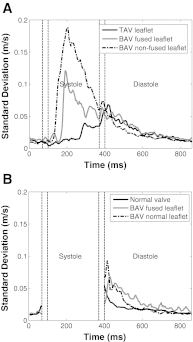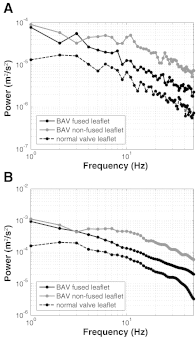The congenital bicuspid aortic valve can experience high-frequency unsteady shear stresses on its leaflet surface
- PMID: 22821994
- PMCID: PMC3468455
- DOI: 10.1152/ajpheart.00829.2011
The congenital bicuspid aortic valve can experience high-frequency unsteady shear stresses on its leaflet surface
Abstract
The bicuspid aortic valve (BAV) is a common congenital malformation of the aortic valve (AV) affecting 1% to 2% of the population. The BAV is predisposed to early degenerative calcification of valve leaflets, and BAV patients constitute 50% of AV stenosis patients. Although evidence shows that genetic defects can play a role in calcification of the BAV leaflets, we hypothesize that drastic changes in the mechanical environment of the BAV elicit pathological responses from the valve and might be concurrently responsible for early calcification. An in vitro model of the BAV was constructed by surgically manipulating a native trileaflet porcine AV. The BAV valve model and a trileaflet AV (TAV) model were tested in an in vitro pulsatile flow loop mimicking physiological hemodynamics. Laser Doppler velocimetry was used to make measurements of fluid shear stresses on the leaflet of the valve models using previously established methodologies. Furthermore, particle image velocimetry was used to visualize the flow fields downstream of the valves and in the sinuses. In the BAV model, flow near the leaflets and fluid shear stresses on the leaflets were much more unsteady than for the TAV model, most likely due to the moderate stenosis in the BAV and the skewed forward flow jet that collided with the aorta wall. This additional unsteadiness occurred during mid- to late-systole and was composed of cycle-to-cycle magnitude variability as well as high-frequency fluctuations about the mean shear stress. It has been demonstrated that the BAV geometry can lead to unsteady shear stresses under physiological flow and pressure conditions. Such altered shear stresses could play a role in accelerated calcification in BAVs.
Figures









References
-
- Adrian RJ, Ferreira RTDS, Boberg T. Turbulent thermal convection in wide horizontal fluid layers. Exp Fluids 4: 121–141, 1986
-
- Adrian RJ, Yao CS. Power spectra of fluid velocities measured by laser Doppler velocimetry. Exp Fluids 5: 17–28, 1986
-
- Balachandran K, Sucosky P, Jo H, Yoganathan AP. Elevated cyclic stretch alters matrix remodeling in aortic valve cusps: implications for degenerative aortic valve disease. Am J Physiol Heart Circ Physiol 296: H756–H764, 2009 - PubMed
-
- Bellhouse BJ, Reid KG. Fluid mechanics of the aortic valve. Br Heart J 31: 391, 1969 - PubMed
-
- Beppu S, Suzuki S, Matsuda H, Ohmori F, Nagata S, Miyatake K. Rapidity of progression of aortic stenosis in patients with congenital bicuspid aortic valves. Am J Cardiol 71: 322–327, 1993 - PubMed
Publication types
MeSH terms
Grants and funding
LinkOut - more resources
Full Text Sources
Medical

